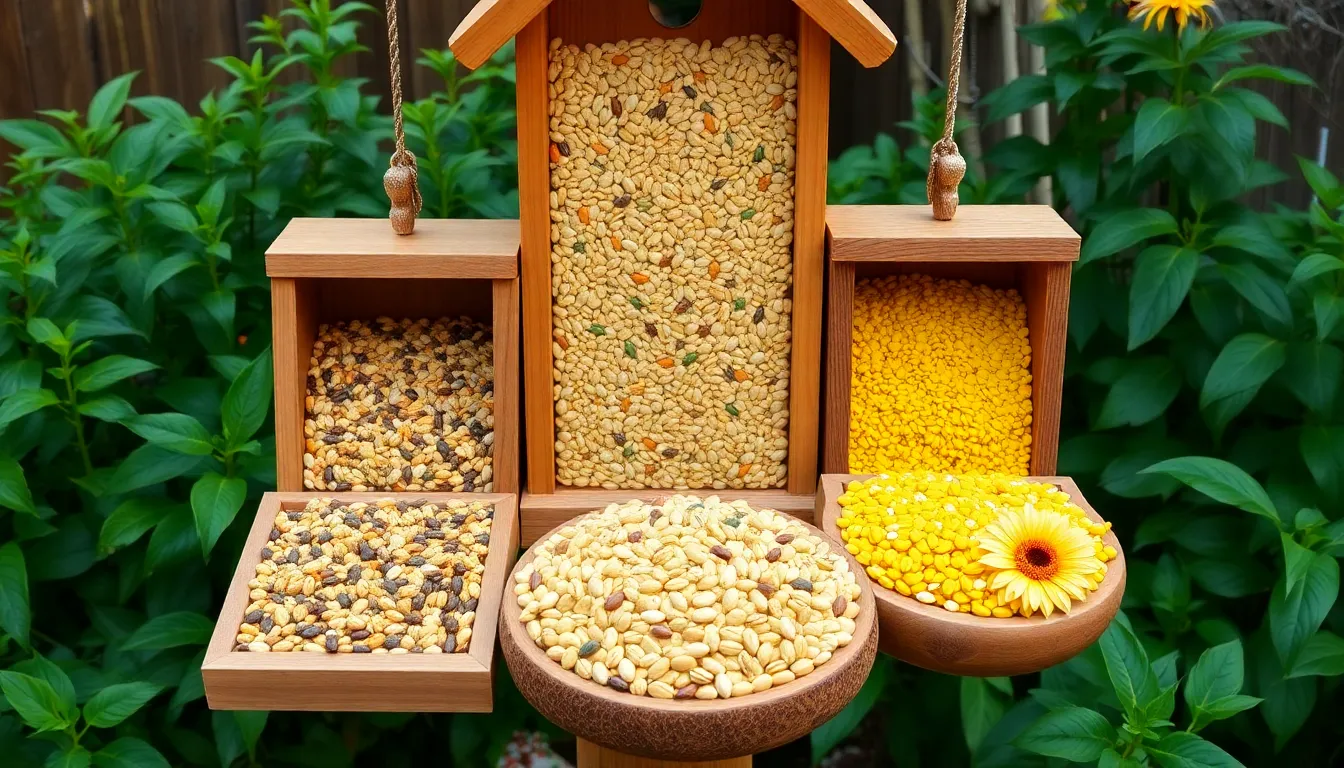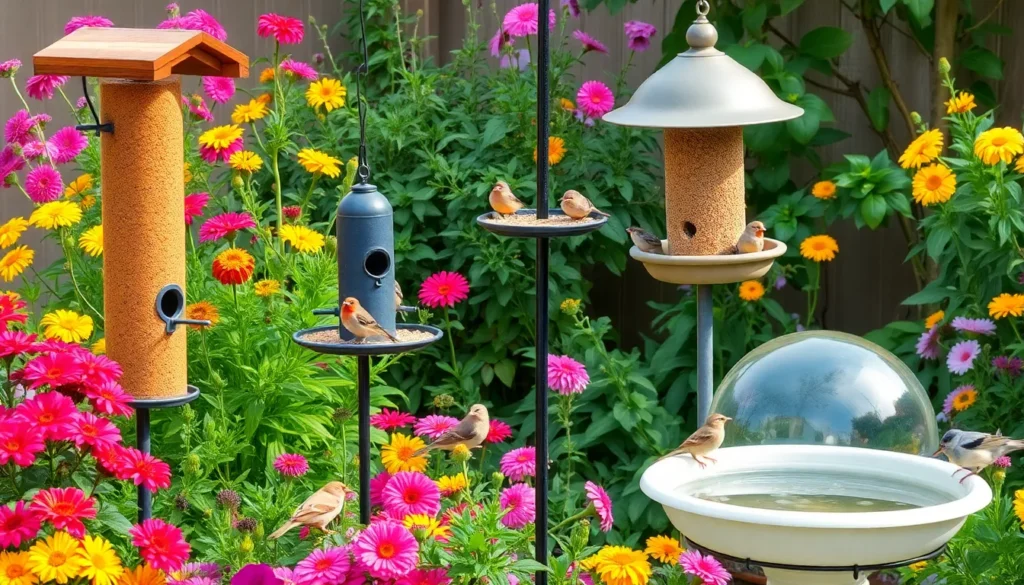Table of Contents
ToggleImagine transforming your backyard into a feathered paradise where colorful birds flit about like nature’s own aerial performers. Attracting birds to a feeder isn’t just about filling it with seeds; it’s about creating an irresistible dining experience that even the fussiest avian connoisseurs can’t resist.
Understanding Bird Feeders
Bird feeders serve as essential tools for attracting a variety of bird species. Providing a selection of feeders enhances the backyard experience, drawing in more visitors.
Types of Bird Feeders
Numerous bird feeders are available, each catering to specific bird types. Tube feeders attract smaller birds like finches. Platform feeders offer an open area that accommodates various species. Hopper feeders dispense seeds slowly, inviting both large and small birds. Suet feeders provide a high-energy option for woodpeckers and other insectivorous birds. Window feeders allow for close-up viewing, appealing to those who enjoy observing birds in action.
Choosing the Right Feeder
Selecting the ideal feeder depends on numerous factors. Consider the bird species in the area, as different types prefer various feeding styles. Think about feeder placement to ensure accessibility and visibility. Evaluate the feeder material; metal and plastic options offer durability. Additionally, prioritize easy cleaning to maintain hygiene. Understanding these factors enables better choices that can effectively attract more birds.
Selecting Bird Food

Selecting the right bird food plays a crucial role in attracting various species to feeders. The ideal food matches local bird preferences and seasonal availability.
Best Seeds for Attracting Birds
Sunflower seeds remain a top choice for attracting many bird species, including cardinals and chickadees. Nyjer seeds attract finches specifically. Safflower seeds prove popular among a wide range of birds but deter squirrels. In addition, millet serves smaller ground-feeding birds, such as juncos and sparrows. Offering a mix of these seeds increases the likelihood of attracting diverse visitors, enhancing the feeding experience.
Seasonal Food Considerations
Bird food needs change with the seasons. In winter, high-energy foods like suet and peanuts are essential to support birds facing colder temperatures. Spring marks the arrival of insects, so seed variety should shift towards nuts and seeds that provide protein. During summer, view bird feeding as an opportunity for hydration; incorporating water sources alongside feeders benefits thirsty birds. Autumn often calls for garden clean-up, but providing leftover sunflower heads gives birds natural food sources while they prepare for migration.
Ideal Location for Bird Feeders
Choosing an ideal location for bird feeders significantly impacts their effectiveness. Strategically placing feeders creates an inviting space for birds while ensuring their safety.
Factors to Consider
Local wildlife patterns influence feeder placement. He or she should place feeders near natural food sources, such as shrubs or trees. Nearby cover provides birds with protection from predators. Consider sunlight exposure; feeders in sunny areas attract birds more readily, allowing them to locate food quickly.
Height and Visibility
Height adds to the feeder’s appeal. Feeders positioned between 5 and 10 feet high attract more birds. They avoid heights that are too low, as this can expose them to danger. Visibility also matters; placing feeders in open spaces increases the likelihood of birds noticing them. Feeders, however, shouldn’t be too exposed since cover from nearby brush offers comfort and security.
Maintenance and Care
Regular maintenance ensures a steady flow of birds to the feeder. Ongoing care keeps the feeding environment safe and inviting.
Cleaning Your Bird Feeder
Cleaning the bird feeder prevents the spread of disease. Frequent scrubbing with a solution of one part vinegar and four parts water removes mold and bacteria. Rinsing thoroughly afterward avoids lingering residues that can harm birds. Monthly cleaning suffices; however, rain or high visitation may necessitate more frequent attention. Disinfecting the feeder annually before the migration season helps maintain hygiene and encourages bird visitation.
Refilling and Monitoring
Refilling the feeder regularly keeps birds fed and returning. Observing the feeder daily offers insights into seed consumption patterns and bird activity. Sufficiently stocked feeders allow for continuous random visits while empty feeders may deter birds. Maintaining a mix of popular seeds attracts a variety of species. Monitoring seed levels prevents waste and ensures freshness for the birds’ dietary needs. Through consistent checks, the backyard remains a vibrant hub for feathered visitors.
Additional Tips for Attracting Birds
Enhancing a backyard can effectively attract more birds. Incorporating supportive elements like bird baths and native plants helps create an inviting environment.
Using Bird Baths
Bird baths offer birds essential water sources for drinking and bathing. Placement in shaded areas helps keep the water cooler, making it more appealing. Maintaining clean water avoids algae growth and keeps birds healthy. Adding rocks or pebbles inside provides stable perches for smaller birds, improving accessibility. Regularly changing the water attracts more species year-round, especially during hot summer months and winter.
Planting Native Vegetation
Native plants provide natural food sources and habitat for birds. Choosing flowers that produce seeds attracts finches and sparrows, while trees supply berries for thrushes and waxwings. Creating diverse layers with shrubs offers shelter from predators and nesting sites for birds. Local flora requires less maintenance and supports local ecosystems, promoting a balanced environment. Incorporating a range of plants ensures a steady food supply in each season, boosting the chances of frequent feathered visitors year-round.
Attracting birds to a feeder requires thoughtful planning and care. By selecting the right feeders and food tailored to local species, individuals can create an inviting atmosphere that encourages feathered visitors. Proper placement of feeders enhances accessibility while providing safety from predators.
Regular maintenance ensures a clean and welcoming environment for birds, promoting their return. Incorporating bird baths and native plants further enriches the backyard experience, offering essential resources and habitats. With these strategies in place, anyone can transform their outdoor space into a lively sanctuary for birds, fostering a deeper connection with nature.







